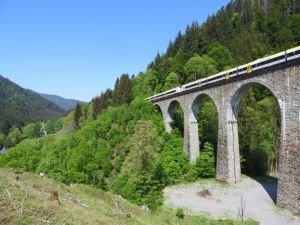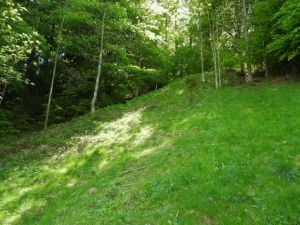Wintersport Feldberg : Différence entre versions
| Ligne 22 : | Ligne 22 : | ||
|thematique=Winter sport@ Outdoor activities | |thematique=Winter sport@ Outdoor activities | ||
|Resume_de=Wintersport auf dem Feldberg | |Resume_de=Wintersport auf dem Feldberg | ||
| + | |Contexte_et_analyse_en=The film begins with a garden shot that shows ice-covered plants, trees and a sign that reads "Christmas 1951". With their Opel Olympia Caprio, the Balkes drive from Freiburg on the B 31 through the Dreisamtal to Himmelreich. The 'Himmelreich' inn is filmed on the left of the moving car, a typical Black Forest courtyard that still exists today. A chapel can be seen on the right, which was later dismantled due to the spread of the main road and rebuilt to the left of the inn. Behind the inn is the Himmelreich train station, where trains going up and down the Höllenbahn meet. | ||
| + | |||
| + | [[Fichier:Ravennnaviadukt 2 Foto Carolin Ponick.JPG|vignette|Das Ravenna-Viadukt wird bis heute von der Eisenbahn genutzt (Foto Carolin Ponick)]] | ||
| + | |||
| + | From Himmelreich, the B 31 leads directly to Höllental, which is known for its 'Hirschsprung' at its narrowest point. The viaduct over the Ravenna Gorge is a striking building. Blown up by German troops at the end of the war, the 27-meter-high Ravenna Viaduct was rebuilt under the French occupation after the Second World War. The route of the Höllentalbahn, which leads over the viaduct, is the steepest railway in Germany. It was inaugurated in 1887. The road continues around the Kreuzfelsen to Hinterzarten. The local train station is the starting point for a walk through the town, where the parish church of the Assumption of Mary is recorded. Curt Balke is filmed in front of the Bruggerhaus, which was built in 1627 as a rectory. The following is a short sequence with a Märklin model train layout size H0, which the grandson probably received for Christmas in 1951. Another trip to Breitnau, which is not far from Hinterzarten, is documented. Ms. Balke stands in front of the Löwen inn. From there, the Wirbstein (mountain name) and the Abrahmenhof (right) and Konradenhof (left) are filmed with a view towards Hinterzarten. There was no closed snow cover on this winter excursion. | ||
| + | |||
| + | Skiing in Feldberg, Neuglashütten | ||
| + | On the journey between Titisee and Feldberg-Bärental, the Seebuck and the Feldberg can be seen behind high snowboards. At the beginning of 1952 a lot of snow fell, which according to the weather station there was up to three meters high. In Feldberg-Neuglashütten, Curt Balke skis past the “Grüner Baum” inn, which still exists today. A pan on Neuglashütten follows. Information signs enable a clear geographical orientation. In the subsequent scenes, the Balke family is shown skiing. This is followed by a stop for coffee and cake in a restaurant, probably in the 'Grüner Baum' inn. The following scene, which Ms. Balke shows on skis, was created on the roadside of the B 500 near Neuglashütten. Mr. Balke attached the skis to the car roof. The license plate 'FB-03-4834' indicates the French zone of occupation, 'FB' stood for the country code 'SüdBaden' at the time. | ||
| + | |||
| + | [[Fichier:Schanze Hinterzarten Foto Carolin Ponick.JPG|vignette|Die Schanze in Hinterzarten wird nicht mehr genutzt und wächst langsam zu (Foto: Carolin Ponick)]] | ||
|Contexte_et_analyse_de=Der Film beginnt mit einer Gartenaufnahme, die eisüberzogene Pflanzen, Bäume und ein Schild mit der Aufschrift „Weihnachten 1951“ zeigt. Mit ihrem Opel Olympia Caprio fahren die Balkes von Freiburg aus auf der B 31 durch das Dreisamtal nach Himmelreich. Aus dem fahrenden Auto heraus wird links das Gasthaus ‚Himmelreich‘ gefilmt, ein typischer Schwarzwaldhof, der bis heute existiert. Rechts ist eine Kapelle zu erkennen, die später wegen der Verbreitung der Bundesstraße zurückgebaut und links neben dem Gasthaus neu errichtet wurde. Hinter dem Gasthof befindet sich der Bahnhof Himmelreich, an dem sich tal- und bergwärts fahrende Züge der Höllenbahn begegnen. | |Contexte_et_analyse_de=Der Film beginnt mit einer Gartenaufnahme, die eisüberzogene Pflanzen, Bäume und ein Schild mit der Aufschrift „Weihnachten 1951“ zeigt. Mit ihrem Opel Olympia Caprio fahren die Balkes von Freiburg aus auf der B 31 durch das Dreisamtal nach Himmelreich. Aus dem fahrenden Auto heraus wird links das Gasthaus ‚Himmelreich‘ gefilmt, ein typischer Schwarzwaldhof, der bis heute existiert. Rechts ist eine Kapelle zu erkennen, die später wegen der Verbreitung der Bundesstraße zurückgebaut und links neben dem Gasthaus neu errichtet wurde. Hinter dem Gasthof befindet sich der Bahnhof Himmelreich, an dem sich tal- und bergwärts fahrende Züge der Höllenbahn begegnen. | ||
| Ligne 44 : | Ligne 54 : | ||
Der erste Skitourist auf dem Feldberg war der französische Konsulatssekretär Dr. R. Pilet im Jahr 1889. Er konnte viele Einheimische für das Skifahren begeistern. Bis in die 1950er Jahre hatten die Skifahrer lediglich einfache Skier aus Holz, die sie für Abfahrt und Langlauf nutzten. Spezielle Ausrüstungen, wie Helme oder wasserabweisende Kleidung, gab es noch nicht. Als Freizeitbeschäftigung fuhren überwiegend begüterte Menschen Ski oder die Bretter wurden beruflich als Fortbewegungsmittel genutzt von Briefträgern, Hebammen und Förstern. Früher kamen im Winter in Hinterzarten viele Schüler auf Skiern zur Schule, und es gab dort auch Skischulen. Der Vater des berühmten Skispringers Georg Thoma war der erste staatlich geprüfte Skilehrer vor dem Zweiten Weltkrieg. Er gab den Gästen des ‚Hotel Adler‘ in Hinterzarten Skiunterricht; sogar Einzelunterricht war möglich. 1951 wurde auf dem Feldberg eine Schwebeseilbahn gebaut. In einer Stunde konnten 240 Personen befördert werden. Anfang der 1970er bis Ende der 1980er Jahre wollte fast jede Gemeinde einen Skilift in ihrem Ort haben. Diese wurden in St. Märgen, Titisee oder Neustadt auch gebaut. Aufgrund des Klimawandels werden die Winter immer wärmer und somit die Schneemengen geringer. Nach zehn Jahren wurden die Lifte abgebaut, da die Schneegrenze sich nach oben verlagert hat, weshalb die Lifte unrentabel wurden. Heute gibt es im Feldberggebiet 38 Skilifte und 63 Pistenkilometer und für die Pisten werden Schneekanonen eingesetzt. Skisport ist nur noch in den Hochlagen möglich. | Der erste Skitourist auf dem Feldberg war der französische Konsulatssekretär Dr. R. Pilet im Jahr 1889. Er konnte viele Einheimische für das Skifahren begeistern. Bis in die 1950er Jahre hatten die Skifahrer lediglich einfache Skier aus Holz, die sie für Abfahrt und Langlauf nutzten. Spezielle Ausrüstungen, wie Helme oder wasserabweisende Kleidung, gab es noch nicht. Als Freizeitbeschäftigung fuhren überwiegend begüterte Menschen Ski oder die Bretter wurden beruflich als Fortbewegungsmittel genutzt von Briefträgern, Hebammen und Förstern. Früher kamen im Winter in Hinterzarten viele Schüler auf Skiern zur Schule, und es gab dort auch Skischulen. Der Vater des berühmten Skispringers Georg Thoma war der erste staatlich geprüfte Skilehrer vor dem Zweiten Weltkrieg. Er gab den Gästen des ‚Hotel Adler‘ in Hinterzarten Skiunterricht; sogar Einzelunterricht war möglich. 1951 wurde auf dem Feldberg eine Schwebeseilbahn gebaut. In einer Stunde konnten 240 Personen befördert werden. Anfang der 1970er bis Ende der 1980er Jahre wollte fast jede Gemeinde einen Skilift in ihrem Ort haben. Diese wurden in St. Märgen, Titisee oder Neustadt auch gebaut. Aufgrund des Klimawandels werden die Winter immer wärmer und somit die Schneemengen geringer. Nach zehn Jahren wurden die Lifte abgebaut, da die Schneegrenze sich nach oben verlagert hat, weshalb die Lifte unrentabel wurden. Heute gibt es im Feldberggebiet 38 Skilifte und 63 Pistenkilometer und für die Pisten werden Schneekanonen eingesetzt. Skisport ist nur noch in den Hochlagen möglich. | ||
Carolin Ponick | Carolin Ponick | ||
| − | |||
| − | |||
| − | |||
| − | |||
| − | |||
| − | |||
| − | |||
| − | |||
}} | }} | ||
Version du 15 juillet 2020 à 09:06
Résumé
Contexte et analyse
The film begins with a garden shot that shows ice-covered plants, trees and a sign that reads "Christmas 1951". With their Opel Olympia Caprio, the Balkes drive from Freiburg on the B 31 through the Dreisamtal to Himmelreich. The 'Himmelreich' inn is filmed on the left of the moving car, a typical Black Forest courtyard that still exists today. A chapel can be seen on the right, which was later dismantled due to the spread of the main road and rebuilt to the left of the inn. Behind the inn is the Himmelreich train station, where trains going up and down the Höllenbahn meet.
From Himmelreich, the B 31 leads directly to Höllental, which is known for its 'Hirschsprung' at its narrowest point. The viaduct over the Ravenna Gorge is a striking building. Blown up by German troops at the end of the war, the 27-meter-high Ravenna Viaduct was rebuilt under the French occupation after the Second World War. The route of the Höllentalbahn, which leads over the viaduct, is the steepest railway in Germany. It was inaugurated in 1887. The road continues around the Kreuzfelsen to Hinterzarten. The local train station is the starting point for a walk through the town, where the parish church of the Assumption of Mary is recorded. Curt Balke is filmed in front of the Bruggerhaus, which was built in 1627 as a rectory. The following is a short sequence with a Märklin model train layout size H0, which the grandson probably received for Christmas in 1951. Another trip to Breitnau, which is not far from Hinterzarten, is documented. Ms. Balke stands in front of the Löwen inn. From there, the Wirbstein (mountain name) and the Abrahmenhof (right) and Konradenhof (left) are filmed with a view towards Hinterzarten. There was no closed snow cover on this winter excursion.
Skiing in Feldberg, Neuglashütten On the journey between Titisee and Feldberg-Bärental, the Seebuck and the Feldberg can be seen behind high snowboards. At the beginning of 1952 a lot of snow fell, which according to the weather station there was up to three meters high. In Feldberg-Neuglashütten, Curt Balke skis past the “Grüner Baum” inn, which still exists today. A pan on Neuglashütten follows. Information signs enable a clear geographical orientation. In the subsequent scenes, the Balke family is shown skiing. This is followed by a stop for coffee and cake in a restaurant, probably in the 'Grüner Baum' inn. The following scene, which Ms. Balke shows on skis, was created on the roadside of the B 500 near Neuglashütten. Mr. Balke attached the skis to the car roof. The license plate 'FB-03-4834' indicates the French zone of occupation, 'FB' stood for the country code 'SüdBaden' at the time.
Lieux ou monuments
- ↑ Cette fiche est en cours de rédaction. À ce titre elle peut être inachevée et contenir des erreurs.







